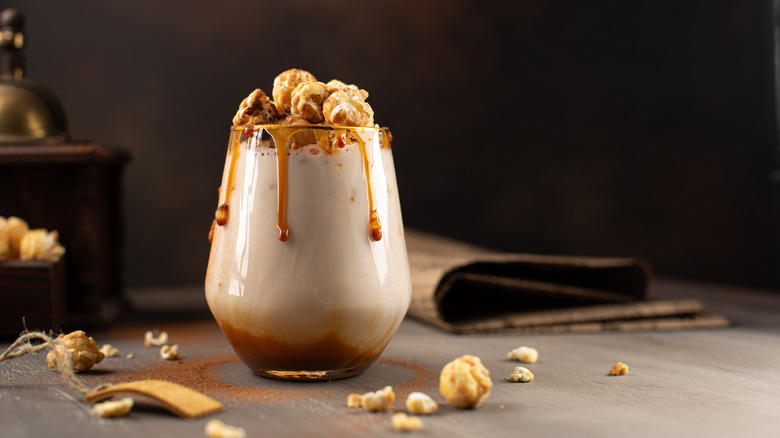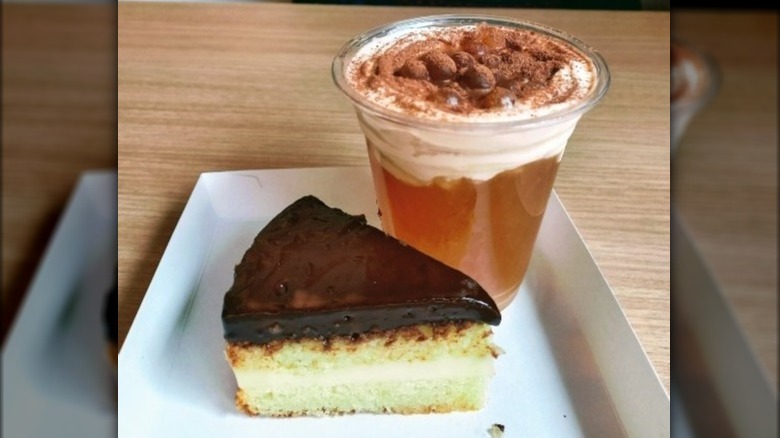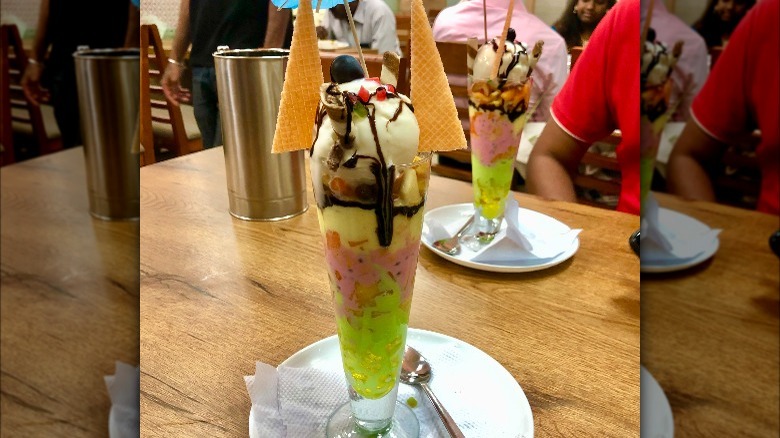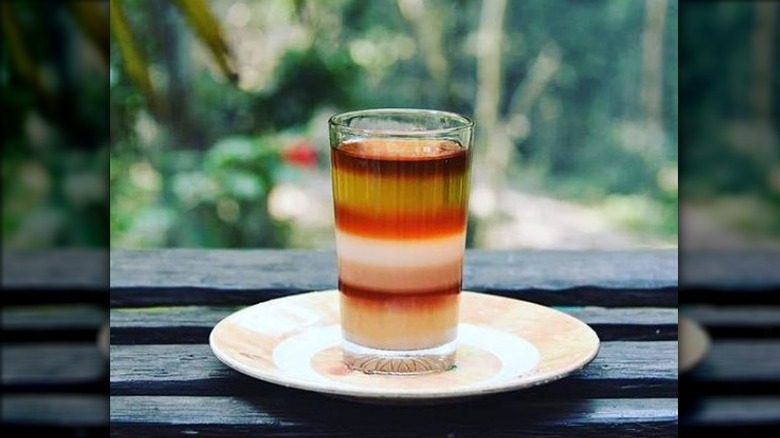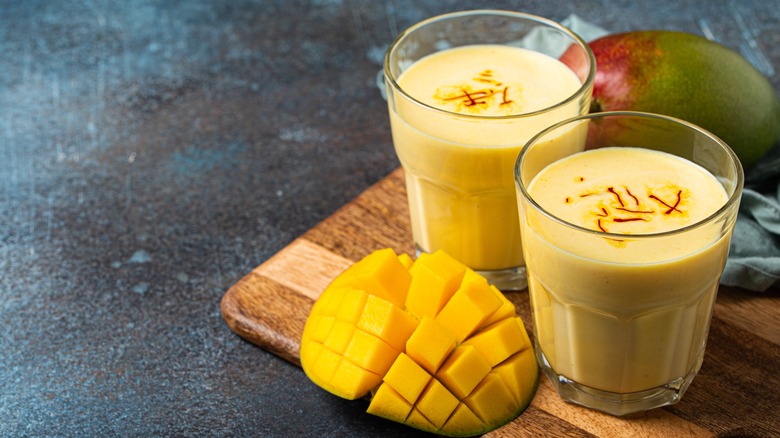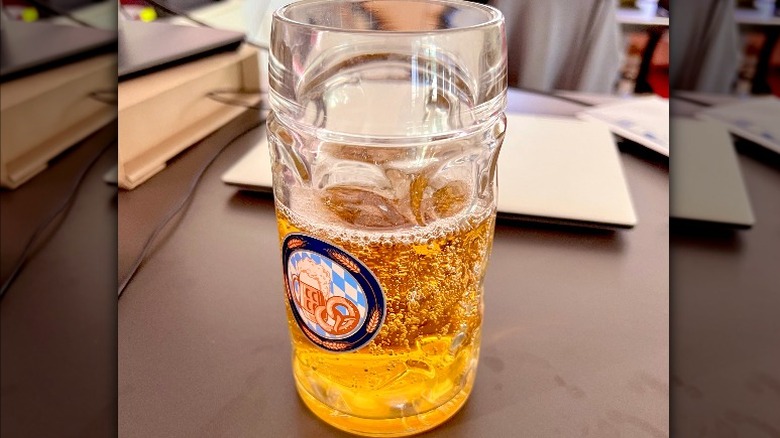The Most Mouth-Watering Dessert Drinks From Around The World
If you live in the United States, you've probably enjoyed the occasional milkshake in the summer or hot chocolate in the winter. However, while these dessert drinks are delicious, they're not necessarily the top picks around the world (even if many countries have a similar take on these well-known classics).
People in other countries have concocted their own mouth-watering dessert drinks throughout the ages using their favorite local ingredients and cooking styles. In many cases, these dessert drinks have wound their way into the regional culture and traditions. While you might find it traditional to drink hot cocoa and chow down on Christmas cookies around the holidays, your friends across the globe have their own much-loved food and, in this case, drink rituals. Thanks to the magic of the internet and its ability to connect us to just about anyone, anywhere, we are privy to these notable drinks and traditions. Who knows — you might just find a new favorite dessert drink and start a tradition of your own.
Halo halo
Ask someone to name a few Filipino foods or drinks and they'll very likely mention halo-halo. The Tagalog word halo-halo translates to mix-mix in English and has pre-World War II Japanese origins (per The Culture Trip). According to Ambeth Ocampo, a historian, halo-halo was inspired by kakigori, a similar sweet and icy drink that was brought to the Philippines by Japanese farmers.
The Filipino people then put their own spin on the drink and named it halo-halo. This dessert drink features shaved ice that is combined with evaporated milk and layered with a variety of mix-ins. While specific ingredients differ depending on where you are in the Phillippines, popular choices include ube jam, bananas, custard, cornflakes, sago, leche flan, nata de coco, monggo beans, and cheese. As noted by The Little Epicurean, halo-halo "showcases how completely different (and sometimes random) ingredients can come together to create something tasty and wonderful!"
Chocolate santafereno
In Colombia, hot chocolate looks pretty similar to what you already know and love, but this chocolate santafereño is not your average envelope of cocoa. According to Thrillist, Colombian hot chocolate, or chocolate santafereño, is made by dissolving a tablet of pure dark chocolate in water. While purists argue that water is the only liquid that should be used, the chocolate bar can also be mixed with milk or a combination of milk and water. The chocolate bars are typically unsweetened, so white or brown sugar is usually added.
What truly sets Columbia's chocolate santafereño apart from other hot cocoas is the addition of white cheese. Just before the warm, dessert drink is served, a dollop or two of queso campesino or queso doble crema are added to the mug. Once the drink is empty, the melted cheese is eaten with a spoon. As Atlas Obscura notes, sometimes the cheesy hot chocolate is paired with more cheese on the side in the form of cheese bread.
Cheese tea
Cheese pops up in a surprising number of dessert drinks around the world. The cheese tea in Taiwan and China, however, doesn't feature savory cheese as you would find in Colombian hot chocolate. Instead, this tea is a little reminiscent of a cheesecake-flavored coffee beverage. According to Atlas Obscura, cheese tea is made by brewing matcha, black, or oolong tea, then topping it with cream cheese, milk, heavy whipping cream, and salt.
The publication says the dessert drink first popped up on street vendor carts in Taiwan in 2010 before it spread around the region. The tea is served cold and is intended to be sipped at a sharp angle, which allows you to get the perfect balance of cheese and tea. While the cream cheese and tea is a pretty flavorful combination all on its own, some have taken to adding extra toppings and mix-ins to their cheese tea, such as chocolate, Oreos, and fruit.
Falooda
Bright, colorful falooda is an Indian summertime favorite that is typically served one of two ways (via NPR). The dessert is either made with a mixture of pistachio ice cream, cold vermicelli noodles, and rose water syrup, and served in a bowl or on a plate, or it's made with milk or ice cream, rose water syrup, cold vermicelli noodles, basil seeds, and pistachios and served in a tall glass. Falooda has a flavor profile that is creamy and rich, and is the perfect dessert after a spicy snack (per Hebbars Kitchen).
While falooda is a popular summertime dessert drink sold in most ice cream shops, restaurants, and from street vendors in India, it's not exclusive to the country. The dessert originated in Persia hundreds of years ago, then made its way to South Asia, Southeast Asia, South America, and Africa via merchants and immigrants (per NPR). Today, you can find it in the United States, though you will find new takes on it. Individual makers draw from their experiences and backgrounds to put their own spin on the drink.
Barraquito
If you'd like your dessert drink with a small kick of alcohol, you can find it in the coffee cocktail known as the barraquito. This alcoholic dessert drink originated in the Canary Islands and local legend credits its name to a man nicknamed Barraco. According to Atlas Obscura, the man ordered the concoction to accompany his meals at the Imperial Bar on Tenerife.
You can now find the barraquito served at most coffee shops throughout the Canary Islands (per Guide to Canary Islands), but the recipe differs slightly depending on the restaurant or bar. Traditionally, the drink features layers of condensed milk, coffee, milk, and Licor 43, which is made with vanilla, citrus, herbs, and spices. The drink is garnished with cinnamon and lemon and topped with frothy milk and a sprinkling of cinnamon. The result is not only aesthetically pleasing but an ideal way to cap off a delicious dinner. While the traditional version is made with liquor, barraquito sin licor, a version without liquor, is also available.
Mangonada
Mangonada has been a popular dessert drink in Mexico for more than 20 years. However, the exact history of this drink is up for debate. It's typically accepted that it originated on the country's streets and became popular in the U.S. around 2010 when Mexican fruit popsicle shops began opening around the country (per DishRoots).
The drink consists of layers of mango sorbet, liquid chamoy (a pickled fruit condiment), lime, and Tajín, and is usually topped with frozen chunks of mango and served in a tall cup. A tamarind and chili paste-coated straw is added to the sweet and spicy drink for good measure (per Atlas Obscura). Those concerned the drink may be too spicy need not worry, as it ranks low on the spice index. Rather than providing a heavy dose of heat, the Tajín is simply used to lightly season the drink.
You can now find a variety of mangonada-flavored treats in dessert shops and restaurants. Refreshing options include mangonada ice cream and mangonada sorbet.
Seven-layer tea
In Bangladesh, seven-layer tea has gained a regional, if not national, fame — but this drink is only available in one spot, and those who've tasted it count themselves lucky. As The Guardian reports, Romesh Ram Gour invented the seven-layer tea, which features a different color and flavor for each layer. He is known to push the boundaries to see how many layers he can fit in one glass beyond seven; his record is 10 layers. The seven layers range from a milky white to a vibrant yellow to a citrus orange to a dark brown, and the flavors range from sweet to spicy. While Gour's recipe is secret, flavor notes include cinnamon, condensed milk, lemon, and cloves (per Atlas Obscura).
According to The Guardian, Gour's restaurant is an unassuming kiosk, but people come from all over to taste his seven-layer tea. There's even a rumor that celebrities have offered to fly Gour out to make the tea for them — Gour declined. Beyond celebrities, Atlas Obscura notes that political figures, such as the prime minister of Bangladesh and the Qatari ambassador, have also sought out the famed tea.
Lassi
According to Smithsonian Magazine, lassi is a dessert drink that is a frozen blend of water, yogurt or buttermilk, fruit, spices, and sugar. Its consistency falls somewhere between a milkshake and milk. The drink comes in a variety of fruity flavors, with mango lassi being the favorite. Common in Northern India, lassi is typically served sweetened or salted. Sweet lassi typically includes rose petals in the flavor profile. Salted lassi, on the other hand, features cumin, ginger, and mint leaves (via Tikkaway). References to lassi date back to around 1000 B.C. and many believe it to be the world's most ancient smoothie.
Lassi is considered a drink with many health benefits, thanks to the yogurt and mango in the recipe. Yogurt is a probiotic that aids in digestion by bringing good bacteria to the digestive system. Mangoes are rich in vitamin C and beta-carotene, which help repair cell growth and make you feel full, respectively (per Tikkaway).
Cendol
Cendol is a Southeast Asian drink that's popular in Indonesia, Singapore, Malaysia, Vietnam, and Thailand. However, it's important to note that this dessert drink differs from place to place. Per The Jakarata Post, Singaporean and Malaysian cendol is served in a glass or bowl, and includes pandan jellies, red azuki beans, sweet corn, sugar, and coconut milk. In Indonesia, cendol is typically only made with jellies, milk, and sugar; jackfruit or other aromatics are added on occasion.
The name cendol has different meanings depending on where you are in Asia. In Malaysia, the term refers to the dessert, while in Java it refers to the green jellies that are "the star of the dish" (per Curious Cuisiniere). The jellies are slightly sweet and made with rice or bean flour, which gives them a texture similar to that of noodles. Pandan leaf gives them their green hue. This unique ingredient gives the drink a punch of color.
Horchata
Horchata is a traditional summertime drink in Mexico that is similar to rice pudding in flavor. It is typically made with water, white rice, milk, condensed milk, and cinnamon (per Cooking Classy).
According to the Journal of Ethnobiology and Ethnomedicine, a horchata-like beverage was enjoyed in ancient Egypt as early as 2400 B.C. This horchata predecessor was adopted by the Romans when they took over Egypt in 30 B.C. The drink spread throughout the Mediterranean region and was picked up by the Spanish. The first use of the word "horchata" (versus the prior Latin terms the Romans used) was recorded in the 1200s in Valencia.
As the drink traveled throughout the world, the recipe evolved to capture each country's preferences. In Spain, horchata is made from barley or tiger nuts, fruit extracts, water, and sugar. In Guatemala, it's made with almonds, cinnamon, vanilla, rice, and sugar. In Venezuela, the dessert drink includes sesame seeds and sugar. Regardless of how you make this ancient drink, though, the result is the same: a simple, sweet, slightly spicy, and delicious dessert beverage.
Shakerato
A shakerato is "Italy's answer to iced coffee" (per The Atlantic). A standard summertime favorite in Italy, a shakerato is typically made with espresso that has been sweetened with sugar syrup and ice. The mixture is shaken and then strained into a glass, and the end result is a sweet and frothy dessert drink. As noted by The New York Times, "The shakerato (pronounced shake-er-AH-toe) should be strained into a glass, not dumped into a to-go cup."
The shaking and straining are the most important parts of making a shakerato. Not only does the process cool the drink so no ice is required in the finished product (which can melt and water down the drink), but it also creates a frothy layer on top, like on a cappuccino. The shakerato is similar to iced coffee, but the defining difference is that iced coffee is served over ice, while a shakerator is not (per Waka Coffee).
Apfelschorle
Apfelschorle is a sweet and refreshing apple juice spritzer that became popular in Germany more than 100 years ago. The simple drink was commonly made in homes and restaurants across the country (per Lindauer Zing) and is now enjoyed in Austria and Switzerland as well (via The Berlin Spectator). An ideal drink for a hot and sweaty day, this drink is simply made with "a mixture of the finest apple juice and clear, sparking mineral water" (per Lindauer Zing). As The Berlin Spectator notes, the resulting drink is not as sweet as apple juice on its own and has fewer calories. Not only is it tasty, but it also quenches your thirst.
Since different brands of carbonated water have various mineral and sodium contents, the final product can differ. Per Just Like Oma, sparkling water with a medium gas and low sodium content makes the best mixer for an apflershorle.
Malt og Appelsin
Around the holidays, warm, festive drinks are a staple. While you can't go wrong with hot chocolate, apple cider, or mulled wine, perhaps you should add malt og Appelsin, an Icelandic Christmas drink, to your menu. The drink is essentially a combination of malt and Appelsin. Traditional Icelandic malt is, as The Reykjavik Grapevine explains, comparable to a sweeter version of a non-alcoholic Guinness. The Appelsin, meanwhile, is an Icelandic orange soda.
The way in which you combine the two ingredients to make this favorite holiday beverage is a topic of debate. Some say you need to have slightly more malt than Appelsin, while others argue that the drink should be made with equal parts of each. Still, others think the ingredients should be mixed with a ratio of 50% malt, 30% Appelsin, and 20% cola, such as Coca-Cola or Pepsi. Want to save yourself some trouble? Hop on over to Iceland and buy it pre-mixed in a giant jug or in individual cans (via the Iceland Monitor).
Atole
Atole is a simple and versatile dessert drink that is especially good during the winter months. As the Chicago Tribune explains, the drink can trace its roots back millennia to the Aztecs and is now considered a traditional Mexican beverage. The warm drink is made with water, milk, cinnamon, and corn flour, which gives it a consistency of a thin porridge. The Chicago Tribune notes that when mixing the atole, it should be "thin and light in warmer months, thicker and heartier in cooler months." When a sweeter kick is desired, Mexican chocolate, fruit, or honey can be added. The drink is typically enjoyed at breakfast. For an untraditional take on the recipe, tequila or orange liqueur can be mixed into the atole.
You can easily make your own mug of this creamy drink at home, but atole chocolate disks are available to make the process even simpler (via goodNes). The discs only need to be melted in hot water and/or milk before the beverage is ready to be enjoyed.
